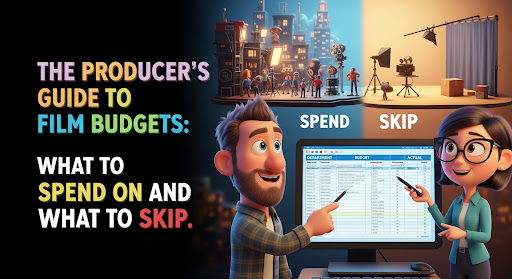The Producer’s Guide to Film Budgets: What to Spend On and What to Skip.

Introduction
A film budget is not merely a spreadsheet of numbers; it’s a blueprint for creative execution and a critical tool for securing and managing investment. For producers, mastering the art of budgeting means knowing where to strategically invest and where to find efficiencies, ensuring the creative vision is realized without financial derailment. A well-constructed budget is a dynamic document, broken down into distinct categories that provide a clear roadmap for the entire production.
The traditional film budget is segmented into four key areas: Above-the-Line (ATL), Below-the-Line (BTL), Post-Production, and Other costs. This structure is more than just a convention; it’s a logical framework for financial planning.
Above-the-Line (ATL) Costs are the first priority. This section covers the “creative talent” that drives the project’s vision, including:
- The producer(s)
- Director
- Screenwriter
- Principal cast
These costs are often the most significant and are typically negotiated upfront. A common pitfall for producers is misallocating resources by overspending on a single high-profile actor, which can starve other critical areas like post-production or marketing. Strategic spending in this area means balancing the need for marketable talent with the project’s overall financial health. For an independent film, for instance, a producer might prioritize a respected director over a superstar actor to attract festival attention and distribution, or secure a well-known actor in a supporting role to lend credibility without breaking the bank.
Below-the-Line (BTL) Costs encompass all the direct physical production expenses. This is where the film is physically built. The BTL section includes:
- Crew salaries (excluding ATL)
- Equipment rentals (cameras, lighting, sound)
- Location fees
- Set construction and props
- Costumes and wardrobe
- Transportation
- Catering
This is an area where careful planning can lead to significant savings. For example, instead of shooting at night, which requires expensive lighting and crew overtime, a producer might opt for “day for night” shooting techniques. Choosing a less famous but equally visually striking location over a high-profile one can save hundreds of thousands of dollars in location fees and permits. Similarly, hiring local crew and renting equipment from local vendors can cut down on travel and accommodation costs. A common mistake here is to underestimate the cost of day-to-day operations, such as catering and transportation, which can quickly add up and eat into the contingency fund.
Post-Production is a frequently underestimated but critical phase. This section covers:
- Editing
- Sound design and mixing
- Visual effects (VFX)
- Music composition and licensing
- Color grading
In today’s market, where visual and auditory quality are paramount, skimping on post-production is a critical error that can compromise the final product’s quality and marketability. A producer should allocate a realistic budget for a skilled editor and sound mixer, as their work can transform a mediocre cut into a compelling film. If a script calls for extensive VFX, a producer must budget for this from the outset, as last-minute additions can be prohibitively expensive.
Other Costs are the miscellaneous but essential expenses that support the production. This includes a crucial contingency fund, typically 10-15% of the total budget, which acts as a safety net for unexpected overages. Skipping this is a cardinal sin of budgeting. This category also covers:
- Insurance
- Legal fees
- Marketing and publicity
- A completion bond for larger productions
A producer’s guide to budgeting must emphasize the importance of this section, as these costs are often what keeps a project afloat when unforeseen challenges arise, from a sudden illness of a cast member to a weather-related delay.
Ultimately, effective budgeting is about prioritizing the elements that will have the greatest impact on the film’s creative and commercial success. It’s about knowing when to invest in a specific talent or a state-of-the-art camera, and when to be resourceful by finding creative solutions. For a producer, the budget is not a set of rigid rules but a living document that must be managed with foresight, flexibility, and a deep understanding of what truly matters to the story being told.

















































